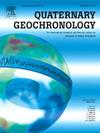非洲南方古猿化石牙齿直接定年的挑战,南非Taung Child型遗址
IF 2.5
2区 地球科学
Q3 GEOGRAPHY, PHYSICAL
引用次数: 0
摘要
本文介绍了在南非东(Taung)附近的Buxton-Norlim Limeworks的非洲南方古猿(Australopithecus africanus)类型遗址的hrdli本文章由计算机程序翻译,如有差异,请以英文原文为准。
The challenges of direct dating of fossil teeth from the Australopithecus africanus, Taung Child type site, South Africa
This paper presents the analyses of Combined Uranium Series and Electron Spin Resonance (US-ESR) dating on enamel fragments from five fossil teeth from the Hrdlička Pinnacle of the Australopithecus africanus Type Site at the Buxton-Norlim Limeworks, near Taung, South Africa. The mammal teeth were recovered from two types of deposits, the A. africanus bearing Pink Claystone (PCS) deposit that formed as layers within the Thabaseek tufa, and the secondary Yellow Red Sandstone (YRSS) deposit that filled cavities eroded through the tufa and PCS. The teeth were dated using enamel fragments following the US-ESR procedure. Two software programs, USESR (Shao et al., 2014) and DATA (Grün et al., 1988) were employed for the age estimation, however, the USESR software encountered numerous challenges, especially in modelling uranium uptake history. This is the first attempt to date a Late Pliocene to Early Pleistocene tufa deposit using US-ESR dating. The complicated history, poor preservation of the samples, and the diagenetic process in the fossil teeth samples make the dating very challenging. Especially as all samples suffered from uranium leaching and three of the five samples had high uranium concentrations in the enamel. This appears to be related to the nature of the tufa environment where high uranium concentrations have also been identified in secondary flowstones formed in caves within the tufa deposits. The final age estimate for the PCS deposits, contemporary with the Taung skull, is a minimum of approximately 2.4 Ma, based on the EU model. Similarly, a minimum age of approximately 1.8 Ma is estimated for the YRSS deposits. The USESR ages (∼2.0 Ma for the PCS deposit and ∼1.3 Ma for the YRSS deposit) were less preferred due to being derived using an extrapolation function. Nevertheless, all results are associated with many uncertainties and complexities and it should be approached with great caution. Another possibility is that the deposit might be challenging to date using the USESR method. The difficulties of dating old sites like Taung in South Africa and in particular tufa environment have been highlighted.
求助全文
通过发布文献求助,成功后即可免费获取论文全文。
去求助
来源期刊

Quaternary Geochronology
地学-地球化学与地球物理
CiteScore
4.40
自引率
22.20%
发文量
130
审稿时长
20 weeks
期刊介绍:
Quaternary Geochronology is an international journal devoted to the publication of the highest-quality, peer-reviewed articles on all aspects of dating methods applicable to the Quaternary Period - the last 2.6 million years of Earth history. Reliable ages are fundamental to place changes in climates, landscapes, flora and fauna - including the evolution and ecological impact of humans - in their correct temporal sequence, and to understand the tempo and mode of geological and biological processes.
 求助内容:
求助内容: 应助结果提醒方式:
应助结果提醒方式:


